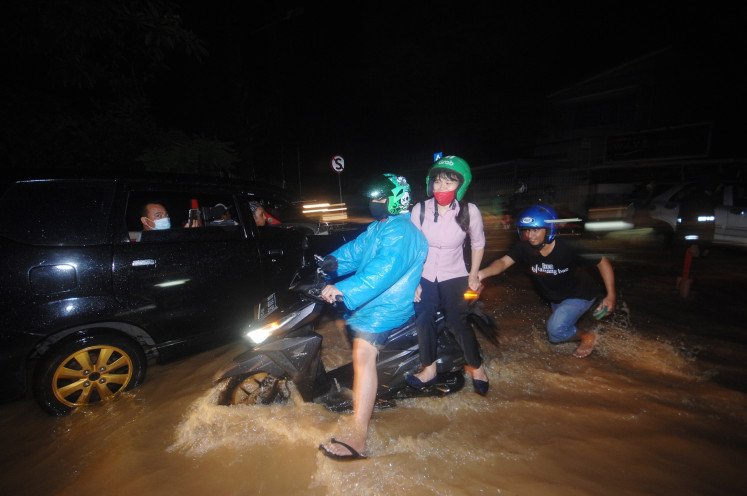As temperatures rise, Indonesia braces for more climate disasters
Comparative data over the past few decades indicate that the rate and frequency of weather hazards have been increasing across the archipelago, with the intensity of disasters worsening due to climate change.
Change text size
Gift Premium Articles
to Anyone

T
he series of weather disasters Indonesia experienced in early January could indicate that the country faces an increased risk of hydrometeorological hazards amid the ongoing climate crisis.
Authorities are urged to adapt disaster preparedness and mitigation measures in alignment with the potential for higher risk, but have been hindered by a limited capacity to brace against future catastrophes.
Data from the National Disaster Mitigation Agency (BNPB) show that Indonesia experienced a rising number of hydrometeorological disasters from 2015 to 2020, six of the hottest years on record according to the World Meteorological Organization (WMO).
BNPB recorded 1,664 disasters in 2015 and then saw the figure increase over the next four years to 3,810 in 2019, with the figure dropping slightly to 3,023 last year.
Indonesia distinguishes hydrometeorological hazards under two categories: wet extreme events comprising floods, landslides and whirlwinds, as well as extreme waves and coastal erosion, and hot extreme events comprising wildfires and droughts.
Wet extreme events dominate the data, led by floods and whirlwinds. In 2020 alone, the country saw 1,138 floods and 902 whirlwinds.
BNPB disaster mapping and risk director Abdul Muhari said the high tally in 2020 was due to La Niña.
“The high risk of extreme weather will continue [through] early 2021, as the weather anomaly usually recedes in March. As a result, hydrometeorological disasters always peak between January ad February,” Abdul told The Jakarta Post on Monday.
Read also: A perfect storm: Indonesia braces for more disasters amid COVID-19, plane investigation
The WMO defines La Niña as “the large-scale cooling of the ocean surface temperatures in the central and eastern equatorial Pacific Ocean, coupled with changes in the tropical atmospheric circulation, namely winds, pressure and rainfall”. The weather phenomenon tends to trigger extreme weather in Indonesia.
High rainfall occurred throughout 2020 in some regions and caused many floods, landslides, whirlwinds and extreme waves. On the other hand, the archipelago saw fewer wildfires and droughts, although the BNPB still received a significant number of reports on both hazards from several regions.
The trend continued through the first few weeks of January 2021, when the country saw at least three major hydrometeorological disasters: a series of landslides in Sumedang, West Java, widespread flooding in all but two regencies in South Kalimantan, as well as flooding and extreme waves in North Sulawesi.

The Meteorology, Climatology and Geophysics Agency (BMKG) projects that Indonesia will experience more frequent occurrences of weather phenomena like La Niña and El Niño. The latter involves warming ocean surface temperatures, the opposite of La Niña.
BMKG head Dwikorita Karnawati told a press briefing on Sunday that the intervals between the two phenomena had shortened in the past few decades, from intervals of between five and seven years in 1950-1980 to between two and three years in 1981-2019.
This could be a cause of the rising number of extreme disasters in Indonesia over the past 30 years, she said, which also saw higher air temperatures and prolonged dry seasons during El Niño and higher rain intensity during La Niña.
Meteorology and climatology professor Edvin Aldrian of the Agency for the Assessment and Application of Technology (BPPT) expanded on Dwikorita’s statement: “In the past 60 years, El Niño and La Niña have increased in both frequency and intensity, although not sharply.
“The main trigger of these extremes is indeed climate change, which could be caused by environmental changes and degradation within and without the country.”
With an average global temperature of around 1.2 degrees Celsius above pre-industrial levels, 2020 tied with 2016 as the two warmest years on record. And while COVID-19 restrictions had cut carbon emissions between 4 and 7 percent last year, the level of atmospheric carbon dioxide had increased and consequently warmed the planet.
Read also: Rich nations 'hugely exaggerate' climate finance: Study
BMKG climatology deputy Herizal said the agency had also recorded an increase in the atmospheric concentration of carbon dioxide (CO2) at its Bukit Koto Tabang global atmospheric monitoring station in West Sumatra. The station recorded a CO2 concentration of 372 parts per million (ppm) in 2004, which had increased by late 2020 to 408 ppm, nearing the global average of 415 ppm.
He added that the average air temperature in Indonesia had also increased annually by 0.03 degrees Celsius over the past 71 years.
Edvin urged the government to improve the nation’s disaster preparedness in light of the increased risk of hydrometeorological hazards, including developing a model for comparing soil water holding capacity and maximum rainfall. This model could then be used to determine the flood hazard risk in a certain area, particularly as flooding was the major cause of weather-related deaths over the past six years.
BNPB data show that hydrometeorological disasters had claimed around 1,900 lives between 2015 and 2020, with the majority of fatalities (1,001 people) linked to flooding.
Abdul said the government was ramping up nationwide mitigation measures against future hydrometeorological hazards, spearheaded by local administrations as mandated by the Regional Administration Law.
However, Abdul said that regional administrations were often hindered by limited capacity, which left them heavily dependent on the central government.
“We are still working on this now, because we’re still in the transition phase of dividing authority between the central government and regional administrations. We are looking to reform the budgeting process for disaster-related sectors in the regions,” he said.









